
Braniff International Airways: The History of an Amazing Airline
From flamboyant livery designs to supersonic Concorde routes, Braniff International’s heritage mapped out a bold chapter in aviation that…
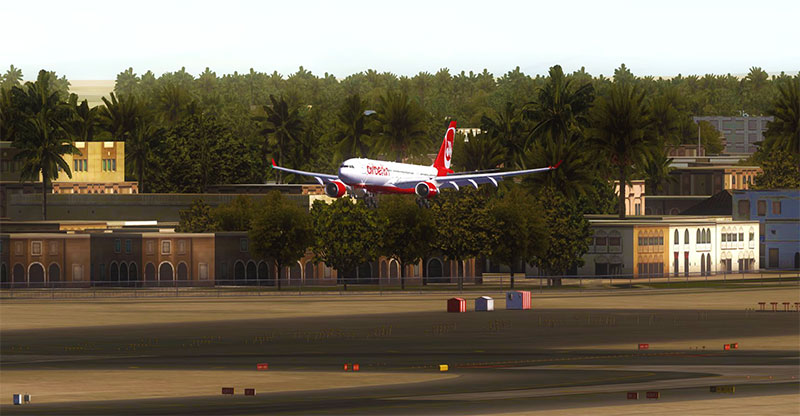
When we examine some of the most up to date programs, software, and add-ons available to the world of flight simulation, it is easy to believe, if only momentarily, that we have reached our zenith and that more realism and authenticity could only be achieved by participating in the “real thing” and taking to the actual skies as opposed to the virtual ones.
However, and in a rather perverse irony, it may well be that not only will the authenticity and accuracy of virtual flight have many more levels to climb through the technological medium of Virtual Reality, but the development of such programs might result in the next generation of “actual” pilots flying thousands of real people across the planet on a daily basis.
While those days may be still a little way off, as we will examine, the merging of the real world and the virtual one would appear to be an inevitable intertwining of realities with, in theory, and at least as far as the community is concerned, beneficial consequences for both the industry and the individual.
Indeed, as we will also examine if, with a large helping of educated speculation, the possibilities for flight simulation are quite literally limited only by the skies themselves.
Before we turn our attention to the future, though, let’s remind ourselves of how we got to where we are today, upon the precipice of such new realities. And indeed, why flight sim, in particular, is a unique entity in the entertainment and gaming industry. Much like its rapid growth and advancements.

As this article is quite lengthy, you can find the table of contents here;
Perhaps in some ways, it seems nonsensical that the simulation would come after the actual thing, but before flight simulation as a way of training pilots, for example, the only way of doing so was to turn over the controls to the aerial students and hope for the best.
While they were quite literally a world away from what is available today, the first recorded case of intentional “flight simulation” took place as far back as 1910 when the first “ground training aircraft” was created upon the orders of several commanders of the French Air Force.
By the late-1920s, the first tentative steps towards what we would recognize as modern simulation were taken with the commissioning and building of a device named the Link Trainer (also known as the “Blue Box”), produced and named after Edward Link in New York. The Link Trainer and developments of it were used up and until World War Two by the United States Air Force.
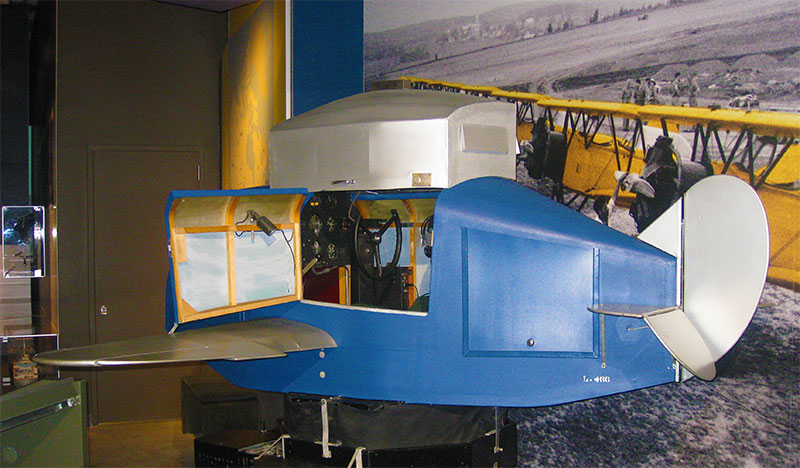
The original "Link Trainer" that resides in a museum.
Of course, with the onslaught of advancement following the end of the Second World War and the “Technological Revolution” which we still very much reside in today, there was a surge of technologies that would take (much) of humanity on to another level of collective existence.
And, as we will examine equally briefly in a moment, the spoils of these industry advancements were, by design, farmed into various industries of the American economy for similarly various reasons. Just one of these is, of course, recreational flight sim.
Of course, the real advancements of flight simulation for purely recreational purposes came about with the rollout of the Internet in the late-1990s and early-2000s, which came at a time when a home computer was as an essential part of every home as opposed to a luxury of the wealthy.
The Internet is really a project still in its (relative) infancy, as are the programs, outlets and everything else that comes with it, including our topic of interest here.
During that time we have gone from only a very select hardcore niche group of people utilizing little known programs few and far between of each other, to worldwide communities who not only take to the virtual skies in planes made from the most up-to-date computer software, but also connect online in such virtual arenas as forums and chatrooms.
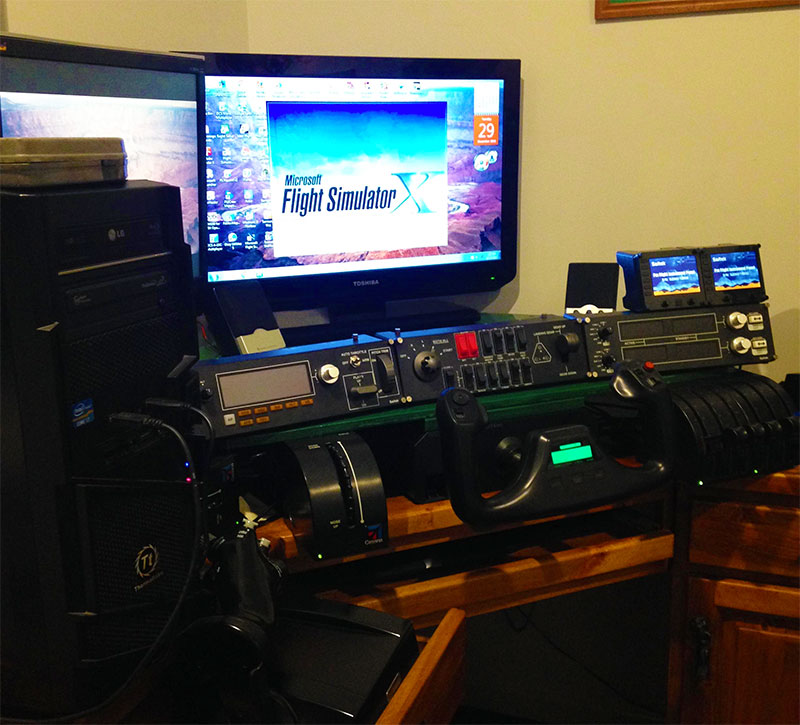
A full personal computer running FSX, not a mobile device.
Of course, it isn’t only the size of the audience that has grown. The details and authenticity of the flying experiences have grown also. From the attention to detail in the planes themselves, as well as the overall detail of the surroundings such as the mountains, countryside, or oceans, or even exact replicas of some of the most iconic and famous cities in the world such as Los Angeles, New York, London, or Paris.
And while we, the collective pilots of the virtual skies enjoy these views for our own personal pleasure, their origins and detailed mappings are a consequence of very real projects and programs in the military and commercial sectors of the aviation world. And it is there, where we will very likely see indicators of what is to come for the virtual aviator.
While flight simulation for recreational purposes will undoubtedly go from strength to strength in the future, any development will most likely come from inside the aviation industry itself off the back of virtual reality simulators used to train their own pilots, which as we have seen goes back over eight decades.
Much like the space industry, advancements in aviation are often “farmed out” to the public through business and enterprise, allowing them to monetize such advancements, meaning the economy as a whole benefit, and in turn, funds are generated for even further developments.
A model that makes perfect sense to most, and one that makes any bitterness in the public budget pill a little more palatable to detractors of the large funds of public monies earmarked for such projects. And while we will not argue the rights or wrongs of such a model, it explains why what is taking place inside the industry is a very accurate predictor of what will take place in the recreational arena.

Inside Airbus' full commercial A330MRTT simulator.
With all of that in mind, then, we should perhaps fully expect the industry to venture down the virtual road to what could offer some of the most authentic and life-like simulation ever seen outside of inner-industry which, incidentally, is making full use of virtual reality flight simulation as you read these very words.
And with such virtual reality simulators, will come the decline of the “sawn-off cockpit” models that have been standard for several decades. After all, the main reason to go down the virtual route is cost and the sheer bulkiness and size of current models, which is essentially, a life-sized front of a real cockpit.
While we should perhaps note that the industry overall is quite divided as to whether virtual simulation will ultimately elbow “flight simulation” out of the industry completely, what might the recreational virtual pilots expect from this minimized version?
Of course, while there will always need to be some form of “intervention” by the respective commercial airlines before appointing their pilots, at least to a certain level, potential pilots will be able, at least in theory, learn how to fly a plane in the comfort of their own home, in front of their own home computer – providing they have the relevant software of course.
If virtual reality flight training becomes, for want of a better word, reality, then given that the main desire for authenticity and realism is what drives the flight sim market, it would only be a matter of time before such programs and potential corresponding technical devices (more on this later) become available to anyone who wants it – for a price.
We wrote about three Boeing 737 home cockpit builders here.
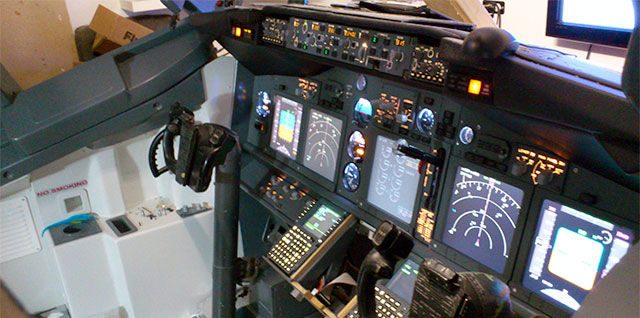
Patrick Kneissl's home Boeing 737 cockpit setup.
And it is in this direction that the world of simulation finds itself heading towards. An interesting twist of the flight sim world and the rapid advancements that are being made in the virtual skies is that while all of the above very much stands firm, there are aspects of the industy that are actually being “driven” by the desires of the audience of the “entertainment” industry.
A senior computer scientist and expert of military advanced gaming technology, Courtney McNamara would state:
"They’re applying a lot of dollars, especially in the game environment, to make these accessible to all user at a very low-cost point!"
She would continue that as well as the price being driven rapidly down to the end consumer, the overall resolutions and technical improvements are just as equally rapid.
Perhaps as an interesting side-note on this last point, it is a good example of the free market pushing overall improvements which ultimately result in the benefit to training pilots.
For example, the competition between such providers of flight simulation technology will scramble to make improvements to their software, as well as making it as palatable, up to date, and as realistic as possible. And the reasons are basic business sense – to keep those already loyal to them using their software, and in an attempt to draw in new customers.
As this scramble to maintain profits progresses, with the only legitimate weapon being genuine improvements on their respective products, increasingly advanced programs and overall experiences emerge. Much like McNamara states above. Furthermore, and with the idea of the ever-present opinions on how government budgets should be spent, she offers:
“The (US) government does not have to invest a lot of its own money into the technology to see it move faster and faster!”
And of course, as the technology improves, the overall ability of those using it improves. A literal win-win for the United States government and military. It is easy to see, then, why it is very much in their interests for such programs to continue to grow.

The tail of a Tui 737 in X-Plane 11 - showing how realistic thing can be.
And it is this last point that is important in understanding not just the community and its place in the gaming or entertainment industry, but why its developments rapidly go against the grain of growth given its “niche” type of appeal.
Realistically, the improvements that we have seen should have taken much longer and been more spread out. After all, as popular as flight sim is, it still only appeals to a relatively small percentage of the populace. However, the improvements are more reminiscent of an activity with a huge and extensive audience.
One would also imagine that “virtual reality” as a whole will vastly improve from the already high plateau it finds itself on currently. For example, the outside world and the images entering the eyes and brain will likely become almost indistinguishable from the “actual” real world.
Indeed, such technological advancements will likely change what it means to fly virtually altogether. This may also open up other, currently unavailable aspects of virtual flight. Might, for example, a virtual pilot be able to experience the actual boarding of and stepping from their plane of choice? Or perhaps they might want to walk around the airport for a little while?

FSX being played on the Oculus Rift.
In short, other aspects of a pilot’s everyday life other than the actual flying of the plane may be an avenue that developers will travel down. Might, for example, pilots have the options to “meet” at such replica airports in the virtual world?
Indeed, the nature, scope and overall appeal of flight simulation may open up dramatically as a result of the apparently inevitable journey into the world of virtual reality. And it may well prove that what is still a niche market now, opens up just dramatically.
We cover a little more on running FSX on the Oculus Rift in this article here.
Or perhaps, multiple “pilots” could assume roles on the same flight, essentially piloting the vehicle as a crew. This would perhaps take on further intriguing possibilities when wartime planes and aerial assault vehicles are used. There would surely be no shortage of virtual pilots who would have an interest in such virtual aerial activities – all experienced from the safety of one’s own home with no danger of any lasting health issues.
Indeed, as technology improves and world events progress, with the recent moon landings – albeit unmanned probes – might virtual versions of such events as the Apollo Moon landings be available to not only relive from a distance, but experience close-up, as if one was there themselves.
What is perhaps interesting about these last points is the educational value that such virtual journeys have. And where there is educational value, those budgetary concerns are sweetened, and more money comes in to meet such demand, and as a consequence, more technological improvements are made.
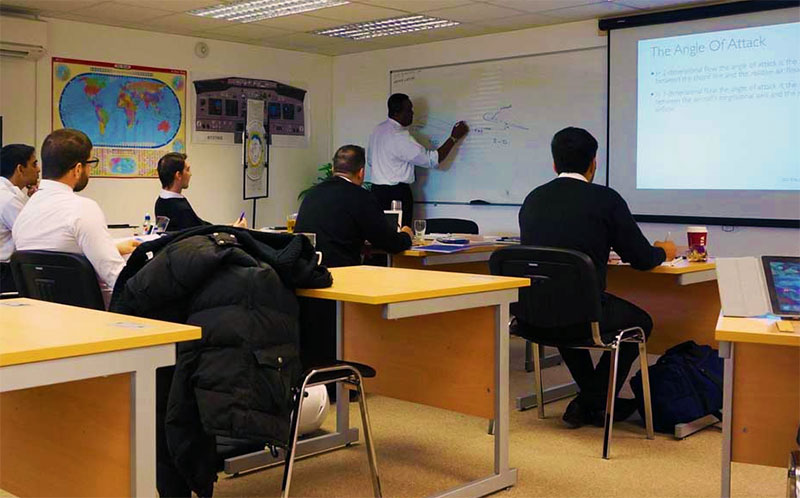
Flight Training at Stapleford Flight Center, my local airfield (EGSG)
The opportunity for school children and even older students to “board a plane” destined for a bombing mission over Europe or a military helicopter over the jungles of Vietnam, for example, while not wanting to glorify the horrors of war, would offer a generation perhaps in danger of losing the sense of just how horrific such battles actually were, the chance to experience them, essentially for themselves. A very true warning from history indeed.
However, with all that being said, the real future of flight simulation, however it is delivered to the user, will always be the actual flying itself. And more specifically, how real the experience feels. And with the aid of ever-increasing technical devices, that realism is perhaps about to be viewed from a whole new angle.
Of course, our imaginations regarding the future, while perhaps having to work within the parameters of educated guesses, are open to speculation.
For example, would specially designed “chairs” become available to complete the authentic experience to the hardcore virtual flyers? Or, accepting that technologically sizing down is seen as advancement, might specially placed and electrically charged “pads” be placed on the limbs and certain parts of the body to aid in mimicking general movement, as well as such things as turbulence or the chaos of having to make an emergency landing? Or pads placed on the fingertips that give the actual feel of “pressing a button”, for example, to feeling the controls “rattle” in their hands?
In fact, it would seem that this is exactly what developers have in mind. Known as “haptic systems” or “force feedback”, the device “transmits vibrations and other sensations” to the end user. The US Air Force has been using such technology in training their pilots for some time, as have several private aviation schools.

A force feedback yoke system which has been running a Kickstarter project.
Perhaps encouraging for recreational users of FS are developments of the program that can be run using a smartphone and a mobile virtual reality headset, which include – at present – wireless and wired options. However, while the smartphone’s wireless virtual reality programs are extremely good for a beginner, more experienced pilots will undoubtedly get more from “tethered headsets” which typically are used with a PC or laptop. And this generally means a more “immersive and realistic cockpit experience”.
In fact, desktop or laptop simulation programs are overall the best options – both now and in future – certainly for pilots who may desire to transfer their virtual skills to the real thing.
There are even several plans to have “VR Pilot” certification set up, available, and recognized in the near future.
While we might think – particularly given Virtual Reality’s overall popularity – that flight simulation and those who participate in it would be eager to embrace such advanced technology that would usher them into an environment, albeit virtual, identical to an actual cockpit.
That all being said, while it certainly isn’t feasible – at least for most people – to have a replica cockpit set up in their spare room, complete with authentic controls, chairs, screens and scenery, many virtual pilots appear resistant to these oncoming changes. As some of them quite rightly point out, there is much to be done and replicated as part of a flight – the changing and recording of charts, reading information, as well as seemingly menial tasks of writing and logging events.

Fabio Ippoliti's home cockpit built on a budget.
Indeed, it is these types of logistical aspects that many virtual flyers regard as “real” and authentic as opposed to the “physical” sensations one might experience when coming in for an emergency landing or going into a sudden dive.
Although all of these aspects will likely be overcome with genuine replacements offered in the virtual flight programs most likely waiting pilots in the near future, there will no doubt a resistance from some.
However, in the virtual world like in the real one, the times they are a-changing.
These programs and technical add-ons and extras are still several years away from the free marketplace and, more importantly, to the end (or common) user. However, the fact they are being used so extensively by industry pilots – military and commercial – and the general take-off of virtual reality, combined with the overall purpose of flight simulation make the merging together and availability of such software a natural one.
And what’s more, given the already sound foundation of long-established FS software such as X-Plane and FSX, to name just two, it is almost certain that any such technological rollouts will be compatible with such favorites.
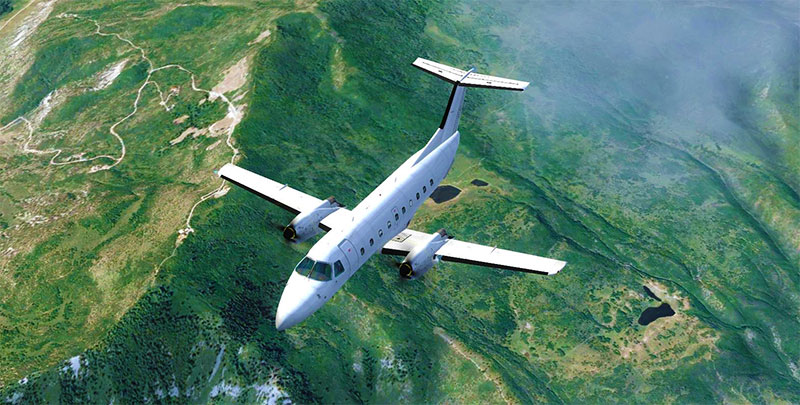
In short, failure to embrace the technology by these already established software owners will not just “make it go away”. Rather it will leave a void in the market just begging to be filled and then the rewards reaped. Whether it is as aviation conventions, private aviation and flight schools, or the commercial and military aviation industries themselves, virtual reality is something to ignore to their own detriment.
Indeed, it very well might be the case that a person sat in their bedroom or living room using virtual reality flight simulation in 2019, for sake of argument, could very well be taking to the skies in charge of a commercial airliner several years from now – their skills developed for full training on such programs. And while that might sound an outlandish and dreamy prospect for many “traditional” virtual flyers, it is a prospect that is perhaps most likely to be thrust upon the flight simulation community sooner rather than later.
Let us know your comments
Please, we really would love to hear your comments below. Where do you think flight simulation will be in the next few years? What do you think will happen to the industry both recreational and commercial? What do you do to make your flights more realistic? Where did your journey start - how long ago and what were you using?
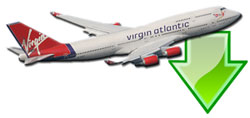 Don't forget... We have a huge selection (over 24,000 files) of free mods and add-ons for MSFS, FSX, P3D & X-Plane in the file library. Files include aircraft, scenery, and utilities All are free-to-download and use - you don't even need to register. Browse on down to the file library here.
Don't forget... We have a huge selection (over 24,000 files) of free mods and add-ons for MSFS, FSX, P3D & X-Plane in the file library. Files include aircraft, scenery, and utilities All are free-to-download and use - you don't even need to register. Browse on down to the file library here.
24 comments
Leave a ResponseThe content of the comments below are entirely the opinions of the individual posting the comment and do not always reflect the views of Fly Away Simulation. We moderate all comments manually before they are approved.
The future of flight simulators will surely focus on more and more performing planes and close to reality see PMDG and as far as scenarios are concerned, we will focus on Google Heart that has reached a very high perfection of scenarios all over the world. 'authorization to access the web live so as not to weigh down the scenarios with hundreds of Gigas. A more intense collaboration can lead to a perfect virtual reality that we hope for the future, a collaboration that can improve the pilot schools both from the point of view of learning and play.
I'm not sure if we're quite there yet.
What I'm seeing from my seat is the incorporation of more real-world parts in home-based sims. Various APIs are available to help interface genuine parts into X-Plane / P3D.
A few examples I have are: Garmin MX-20 Moving map system interfaced to X-Plane, a Sigtronics 4-place intercom, light plates, timers, Avidyne PFDs, Beechcraft engine gauges, cabin pressure gauges.. the list goes on.
I used to fly regularly, but haven't since 2005 as my sim hobby kicked into high gear.
I have been so passionate about aviation. I have a particularly Microsoft Flight Simulator X. I have been using it for more than 8 years now, it has really helped me in my training as a student pilot as I work on getting my PPL done soon. What would really help me is getting a full yoke and throttle set and pedals, I use Payware and freeware add-ons in my simulation experience.
There will hopefully be older aircraft that will be able to interact from startup to shutdown. Hopefully, for me the Boeing 707 as it's my favorite aircraft. More interactivity with ground control and while in flight.
I started with Microsoft 2004 FS, then 2009 FS and now use the FSX. At 82+ years old I hope the FS gets better for you youngmen. As long as there's interest the Sky's the limit.
I have been flying various and sundry flight simulators since the days of Commodore 64 in 1984, so that most definitely means I predate a lot of the latter-generation simmers here.
FS5 was an early standout and I have progressively enjoyed each new generation's improvements as they've come along. When FSX came along, I saw in it what I felt to be at least a framework upon which to build a long-term relationship, and I've stuck with it as my primary go-to on various different hardware platforms ever since.
I have supplemented it with a substantial investment in payware add-ons and upgrades until I've been the hangar collections of my dreams, and through the totally immersive elements of the software, have had extensive adventures in challenging airframes all over the world. But while there is value in continuous improvement, one must balance its potential benefits with its present cost.
One thing I have always disliked about any version of digital 'entertainment' is this seeming rush for the "next best thing" every few months until one begins to despise the hype and the relentless proprietary money-making, etc. Sometimes one has to reach the conclusion that while others might decry my older system as antiquated, I have chosen to accept it as "good enough for me". Hell, there are still FS 2002 and 2004 flyers out there, so I can be no worse.
If I were just starting out as a young buck in my early 20s like I was back in 1984, OF COURSE, I'd jump on the latest version of PREPAR3D, have the most powerful SSDs for storage of all my operating software, and be running it with the fastest graphics drivers possible. But at twice-plus that age, I no longer have the interest nor the resources to keep chasing that brass ring and making new developers rich.
The industry simply MUST NOT FORGET those of us who's patronage of their early business was the FOUNDATION OF THIS INDUSTRY in the first place!!! The bottom line of all of this must remain that nebulous factor that supersedes the latest tech, the fastest hardware, the newest VR, or the next shiny object to come down the pike in a few weeks.
One must ultimately decide how much time, effort and money to invest (or waste) in simulation, in comparison with HOW MUCH ENJOYMENT they derive from it. YES, I have used my FSX (and earlier iterations) to enhance my real-world PPL training. YES, I have used some of the FSX testing, review and academic training to help pass FAA exams. But NO, I have never expected the virtual world to replace or supplant, or even to surpass real flying in the real world. And yet, my "good enough for me" system still fuels the memories, still inspires that first love of flying I got at the age of 11 in 1971 in rural Michigan, sitting in the pilot's seat of a family friend's Taylorcraft BC-12, the freedom of soaring into the sky, the view of the world sinking away beneath me, and then for a few brief 15 or so minutes, taking the yoke, pedals and throttle under my own command.
I don't care so much about the "WORK" of flying scheduled loads in tube-liners, about multi-G high-performance, about sophisticated automated flight controls and strict fly-by-computer protocols where one basically monitors glass cockpits while picking one's nose.
I've got countless hundreds if not thousands of hours doing all that. But give me a small, fragile aircraft, something maybe with a bit of STOL, maybe a nice loud round-engine with a lot of brass, and a wilderness or remote setting to explore-- hand-flying the damned thing, seat-of-the-pants-- and THAT'S what real flying is all about.
My first solo was in an Air Force T-37 in March 1964. I have every rating including ATP (except for rotary.) Owned four planes, the last was a Seneca 1.
After retiring, operating that was way too expensive. Flight instructed for fifty years; hardly ever charging and one of my life accomplishments is now hearing from airline captains I helped get rated many years ago. Most could never have afforded the expense.
Recently checked on getting a light sport rating at a local school that uses an amphibian. The 300 an hour dual ended that dream! SO at eighty, I fly my Flight Sim X every day and thanks to Fly Away Sim I can fly the T-37 again! Also, all the planes I've owned; Ercoupe; C172; C182RG and my Seneca 1.
The small charge each month is more than worth it. Love flying the Concorde IFR all over the world. Love visiting the airports in states where I used to instruct. Amazing what memories return and how pleasant it is to look in my three log books covering five thousand hours and refly trips even those with exciting moments such as engine loss in the twin. Pitot ice when IFR among others.
I think the cost of flying and owning aircraft has gotten to the point that the actual pilot population is not growing as it was when I was learning over fifty years ago. I try to introduce youth to Flight Sim and encourage them to become proficient and enjoy flying a simulator.
Most will never fly a plane but the satisfaction of mastering an airplane on FS is a desirable substitute. For me the more realistic the scenery and aircraft replica are will motivate me even more.
I greatly appreciate all the men and women who dedicate themselves to reproduce so many aircraft not available on the stock FS. The small monthly amount Fly Away costs is well worth it. THANKS
When you discuss the comparison of flight simulation to real piloting it always seems as if the real difference is usually ignored. To me (retired USAF with 13,200 hours in real cockpits learning in real aircraft and a link trainer) the difference is simple and meaningful.
When you fail in a simulator you reset....examine why you failed...and try again. When you fail in a real aircraft, all too often you die. There is a fundamental difference there... pilot competence can never be decided in a simulator.
I started my real flying in the Marines in 1969 right after the Marines had been pulled out of Vietnam. At that point, with the Marines no longer needing the pilots they already had who had lots of flying time and a good amount of combat experience, I shouldn't have been surprised (though I was) when I was dropped from flight training at about the halfway point.
The biggest aircraft I flew was the T-28B. All this is to say that I never got my fill of flying the big stuff in the FMF, and--fun though it was--ended up having to make do with flying only little stuff as a Private pilot since--because of other financial obligations--my flying money was quite limited. But even though, today, I still fly for real to give myself and my grandkids that thrill that only real flying can give, I still crave the challenge of flying the big iron.
The only place I can do that, though, is on my flight simulator. I do that by downloading the most sophisticated and complicated aircraft I can find along with their military flight manuals which I study intently.
If both the aircraft and the procedures for flying and tactically operating it are not as real as possible, I won't have anything to do with it. I'm not interested in "games". There's no way I can fly the big iron for real now, but "pretend flying" beats the heck out of "just reading about" airplanes.
I'm sure I'm not the only one who thinks this way. Bottom line: keep pushing the envelope. Make the equipment and software models as real and as complex as possible. Believe me, we'll buy it ... ALL of it!
I can imagine that flight simulation could become three dimensional, as has been done in the film industry. With the excellent scenery, aircraft and weather settings, 3D Flight Sim would be the ultimate enjoyment.
Being ex-RAF, I have been involved with aircraft for most of my life and have been hooked on Flight sim since retiring in 2002. FSX is my current simulation and, I think, one of the best. It is disappointing to know that future budding simmers are unable to buy FSX any more.
I have not ventured into Steam or P3D but it seems that FSX has provided more freedom of operation.
I think maybe it's time for the various simulators to tap into ADSB and have real world aircraft in our simulators.
I have been using Flight Simulators since the early days of computing. Today we use modern FS strapped to Google Earth to support real world not for profit research in multi-science programmes. My favourite airplane is the Pilatus Porter for this and favourite SIM is LM Prepare3D today.
Only wish is for higher resolution Google Earth and easier linking the FS to this.
I am looking forward to possibilities of FS with a timeline - the ability to traverse a virtual earth in the past or the future and the FS to be a real tool to explore.
Or how about a grand scale of exploring the solar system too - we have the virtual technology today. If high resolution images can be taken of the actual complete Martian surface then the FS community could add value by humans performing painstaking virtual research etc, adding value from what was once thought of as a game.
Nobody seems to have developed a flight sim program for the Folland/Hawker Gnat fighter/trainer. Would you possibly consider this, especially with working flight controls, wheel cover/air brakes and working ejector seat?
I have always loved flying. And I would like at this time to thank all the folks that put out the weekly letter with downloads and everything you folks do... Would like to see more Helicopters on here though thanks folks
After trying VR with DCS: World, the future of flight sim is most definitely VR in my opinion. The levels of immersion are vastly greater - it's moving the player from being in front of a picture of a cockpit to actually sitting in it. Sure , there are quite a few technological hurdles to overcome - industry to date seems to have been concentrating on headset resolution, the big breakthrough required is haptic gloves so that the player can interact naturally with the switches and buttons in the virtual cockpit, feeling the dial turn to the correct position or the switch clicking into position. We're not there yet but it is surely on the way within the next 5 - 10 years.
I began my experience back in the late 1980's on a friend's simple PC. Starting with FS 5 I've gradually progressed through each iteration until now I use both Prepar3d and, as well, latterly, X Plane. I also have the Fly Inside flight Sim but don't use it as I prefer European flights.
So what do I think/want? Previous answers sum it up, access to better worldwide data, with 3d modelling, hopefully eventually becoming 'alive' with movements in cities of people/cars etc., but also with the 3d element.
I use VR now and love it - surely the time will come when sensors enable us to feel as though we are moving up, down and around? Initially that may have to be through hardware but that is acceptable for now...
As an avid fan, I would say that my primary concern is for future developments to essentially create a world where everything is copied as in real life - perfect replicas of procedures and the like. But stop, there are many of us who want a 'lite; version, I want a co-pilot to do that difficult stuff, and just let me 'fly'.
I'm not wrong, nor are those who want total authenticity - but it is a simulation - and I for one can't even get on a ladder without getting dizzy, so let me, and many like me, enjoy our representation of what flying is like - and let those who love realism to the nth degree their enjoyment as well.
Of all the expectations, having other people in the sims is what I want - it is a lonely world without interaction.
As for Fly Inside, please get Europe scenery on board asap.......
Good luck to all simmers, the future can only get better given how far we've come in the last 20 years......
I believe the future of flight sim is going to be in the scenery and better graphics on the aircraft.
I remember the original "Virtual" flight simulators they had for computers when PCs were starting to gain popularity and they certainly are a world apart from what is available today.
Just a quick note that I should share with others, when people refer to flight simulators as "games", I correct them and tell them that it's not really a game because you're in a situation that simulates flying an aircraft that range from a single engine Cessna to the Boeing 747 or the Airbus A380, and it involves a lot more thinking and skills in the various stages of the flight, rather than being involved in the various situations simulated in various "games", which is the trait of most games, whether it's on a game console or a computer.
As an Ex-pilot, I can only say that flight simulation for me was such a help.
If I found myself flying on a route that I was not familiar with, I would go to FSX and 'fly' the route beforehand, giving myself the opportunity of getting familiar with the upcoming flight and route.
The better the scenery was, the more at home I felt. Of course, it goes without saying that the aircraft being used should be exactly like the real plane which most was.
The downside of it all was the cost - I personally think that having to pay over £90.00 UK was iniquitous, even though I recognize the work that had been put into producing such a simulated aircraft.
For many years I have read comments by groups concerning the future of this or that.
In addition to flight simulation, I am an avid stamp collector, railroad historian and model railroader. In the stamp and modeling communities, there is a constant din about the hobby dying or having no direction. Both are quite wrong, resulting from a failure to evaluate the past.
I do not think this is true with flight simulators. I started simming back in the mid-1980s, around the time I first got a DOS computer, when it was all lines and black and white (1986?). I dropped out for quite a long time until I retired in 2014 and picked it up again thanks to a renewed interest in aviation in general and picking up a copy of PC Pilot at a local Barnes and Noble.
The advancements absolutely blew me away, and I happily dove it. I am learning to fly all over again, but I must admit it is much easier and more enjoyable to fly a 2019 sim Cessna 172 than it was in the early 1990s! When I returned to flight simulation, I jumped into FSX, but within about two years, switched to P3D due to the 64-bit architecture.
I feel very at home with this system and will probably not change in the near future. I still have a lot of learning to become a proficient sim pilot. Almost everything about simming today impresses me. The quality of the graphics, the extensive scenery, hardware, and the wide range of aircraft both free and payware.
There are two things that are impediments to my enjoyment. First, some software setups are balky. I had a heck of a time figuring out how to install and implement FSUIPC and SPADneXt in FSX, but it was quite easier in P3D. To the novice, figuring out the file structure for installing some freeware was daunting, to say the least.
In the first year, I probably had more uninstalled freeware packages than installed! I am an old guy, so I tend toward the written word. Lack of hard-copy documentation is difficult for me.
Google, YouTube, and other online sources are nice and useful, but just not comfortable. I like pulling our a manual and reading it, say in the evening with a cup of coffee while ignoring the ongoing TV show.
Since I was about seven years old, I’ve ended my day reading in bed. Not too easy with a PC. I know this is not a major factor to most, in the same way, most don’t miss album liner notes! But I imagine a lot of us over 55 would still appreciate hard copies.
In general, pretty minor problems.
Where does simming go in the future? I suppose VR is the new frontier, and I am thinking of jumping in at some time in the future. Not looking forward to abandoning my current investment in software and cockpit hardware, but I suppose it will come.
For the time being, I need to become more proficient. The thing I think can be improved upon in the future is historic scenery in which to fly historic aircraft. I don’t like flying a TWA Constellation into modern-day Lambert field. I’d love flying it into 1950s-era Lambert field! For the Big Two (P3D and X-Plane), I’d like some entrepreneur take a shot at producing historical scenery rather than all scenery being current day.
It would be nice to see historic airfields with super-detailed buildings. It would make flying vintage general and commercial aircraft into major airports a lot more realistic.
Along this same line, there seems to be this thick wall between flight simulators offering all kinds of commercial and general aircraft, and many very complex military aircraft (with no one to fight), and companies that offer flight combat only. I am not a developer, so perhaps I don’t see the problems, but why can’t the P3D, for example, platform offer it all?
Somedays I might want to fly a Beech Barron from Denver to Dallas, and other times I’d like to take on the Nazis with a P-38. I’d like to do this within the same platform rather than have to learn P3D and some other platform. Is it possible for this to happen?
I’d like to see some data on what people actually fly and fly well. Do people find themselves spending more time in simpler general aviation aircraft or commercial models? Do the amazing “study” versions get used by a large number of simmers, or are they bought and sit on the shelf (hard drive)?
In my opinion, it is almost impossible to jump into a 747-800 and enjoy the aircraft without many, many hours of hard work. On the other hand, a Cessna Twin is much easier to learn and actually get flying more quickly. I am probably too long already, so I will close by saying that I love the current state of flight simulation. Being “reborn” into the hobby, I think if it all stopped right now, I would have many years of enjoyable flying.
I look forward to what the movers and shakers come up with, and I think I will be pleasantly surprised.
I have FS with 3 32 inch monitors and one 15 inches for gauges. I'm interested in regional aircraft for short flight that you can undock the views. Can you send info to this email? Thanks, Don Hart.
I would like to say to begin with, that I am not a real pilot. Just a virtual one.
I started out on an Apple IIc flying the little "stick figure" planes. And then like everyone else who likes flight sims graduated to the next operating system. The graphics improved to what I would describe as"cartoon graphics". In fact, my favorite flight game runs on a 486 operating system. I have kept that old 486 just for that one game.
I would purchase flight games even before I had the operating system to run them. I have all of the Microsoft flight sims. I guess you could say that I am a flight sim nut. I like FS9, because of the historic planes and flights. I like FSX because the graphics are better, and there are more planes available.
X-Plane has good graphics but not enough planes yet. I believe the future on flight simulation is in good hands as there are a plethora of talented developers out there.
Thank you Flyaway for your site. By the way, my favorite plane is the B-17.
Hey, guys, I live in Barbados in the Caribbean... my airport here is Grantly Adams Int. [ BGI ] Can you tell me where to get a free recent/modern upload for this airport and its neighbor islands?
I've been flying with only MSFS since 1999. Now I can say that I've lost my eager to play with it for the last 5 years.
Once you are airborn the dull moments starts and the excitement starts again when you start to decent. So it is mostly a dull and monotone game. Two things must be done to save the game and its fans.
One is the enhancement of the graphics and secondly more more missions. I also play train simulator and I love the scenarios. It is like racing and earning medals.
So we must encourage the fans of FSX and the ones who are building add-ons to write challenging scenarios. I hope the coming new FS will be good in graphics and full of scenarios, missions. You can also sell the new missions on the market. Prof. Dr. Umit Simsek /Istanbul Turkey.